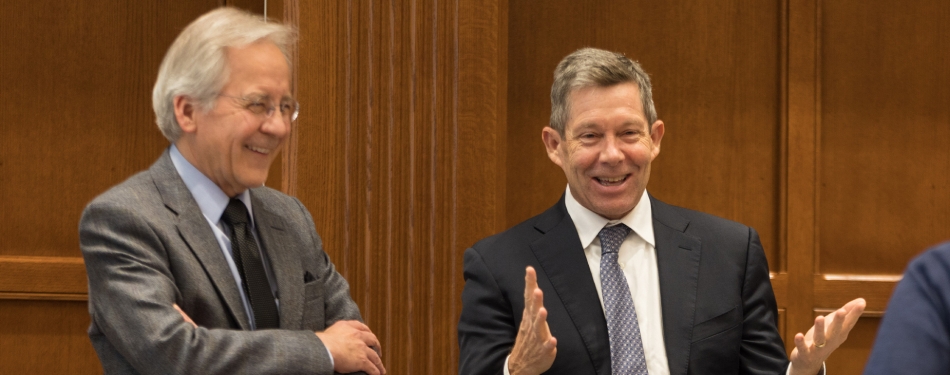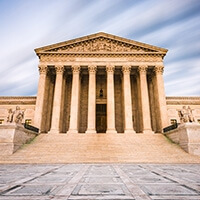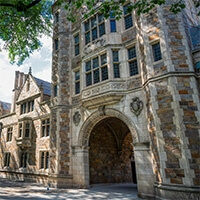By any standard, adjudicating at the highest level of the legal system is no task for the faint of heart. Recently, the Law School played host to Jeffrey Minear, ’82, counselor to Chief Justice John Roberts, and the Hon. Jeffrey S. Sutton, chief judge of the US Court of Appeals for the Sixth Circuit. During their talk, “The Federal Judiciary in the 21st Century,” they offered an insider’s look at the judicial system and their opinions on the courts’ constitutional roles and responsibilities to the American government and its democratic institutions.
The event was co-sponsored by Michigan Law, the Gerald R. Ford School of Public Policy, and the Big Ten Collaboration, an intercollegiate effort to offer shared programming around issues and challenges facing modern democracy.
During their conversation, Minear and Judge Sutton covered a wide range of topics and debated the relevance and role of today’s US Supreme Court, beginning with its founding. Below are four key takeaways from their discussion.
Four takeaways from the event:
1. The core structure of the Court remains in working order.
Citing governmental checks and balances, Judge Sutton kicked off the discussion by asking how an unelected, politically unaccountable judiciary promotes and facilitates democracy.
Minear noted that the judiciary has the distinction of being the only branch of government that does not run on an electoral system, and therefore is more concerned with the long-term impact of its decisions. “It really reflects the genius of the framers of the Constitution, who were naturally skeptical of a national government,” he said. “They recognized that even a democratically elected Congress and president could engage in excess. The framers formulated the idea of a judiciary to establish the guardrails and to police those excesses. And in that sense, the Court has been very effective in promoting democracy by ensuring that those two branches stay within the rule of law.”
2. Confidence in the Court lies in its written opinions.
In an environment that is often divided along political lines, the US Supreme Court faces a great deal of public scrutiny, which can undermine confidence in the institution.
“I think people would have higher confidence in the Court overall if they read the opinions and saw how the justices are grappling with these issues,” said Minear. “I think the media really only focuses on five out of 70 cases, and they talk about them primarily in terms of result. But in each of those cases, you see there are very legitimate arguments on both sides. These are not easy matters. I think the public would have greater confidence if they had time to actually see the analysis that’s taking place.”
Judge Sutton added, “Another way to put it is that sometimes the Court is performing at its best and most admirably when they do something that’s deeply unpopular. It’s a key feature of judging that the rule of law often requires judges to vote against their personal preferences and that, either way, we are forced to explain our vote through an opinion. Over time, the people get to see whether we stand by that reasoning or bob and weave in convenient ways. You can’t really hide from that long-term assessment, which I think is very healthy.”
3. The US Supreme Court should not do more than what is needed.
Much of the discussion centered on the appropriate role of state courts and the federal courts, and how the trend has leaned toward a “top-down” approach to decision making. The panelists debated whether this trend has imposed an outsized role on the US Supreme Court in making decisions regarding American policy.
“I think we Americans in some ways are responsible for sidelining the state courts. We’ve come to love the story of the US Supreme Court nationalizing many rights because sometimes they’re seen as heroic, as in the case of Brown v. Board of Education. So we want to repeat that story. The problem is the US Supreme Court, like any government body, is not always right,” explained Judge Sutton. “One thing we could do that might shrink the footprint of the federal courts is to put the state courts in the vanguard of rights innovation, as more of the first responders when it comes to new challenges to liberty, property, or equality.”
Minear took the opportunity to make a cross-cultural comparison. “The Court of Justice of the European Union has a principle called ‘subsidiarity.’ The notion here is that an issue should always be resolved at the lowest level of government that can competently handle it. Any decision that can be made at the local level should be, and only the matters that require national attention should be made nationally, which they think is necessary to preserve their union.”
4. Look to historical events to guide the future.
Many of the concepts discussed, such as differing methods of interpreting the law, were largely theoretical—however, the conversation remained grounded in history. Judge Sutton recounted an incident that resulted in a constitutional crisis in the state of Kentucky from 1824 to 1826. Prompted by power struggles between the legislature and judiciary, a court schism led to the creation of dueling judicial bodies, the “Old Court” versus the “New Court.” Each claimed to be the rightful court of appeals.
“Kentucky had two years where they did not have a highest court to resolve the meaning of statutes or constitutions in a final way. Ultimately, they held an election in which the Old Court won, and it invalidated all the new court decisions,” Judge Sutton said. “It’s a great lesson for judges and citizens. There’s a real risk when you go down the road of politicizing courts because you can end up without a functioning court system. Do not take the rule of law for granted.”
Banner photo: Jeffrey Minear, ’82, (left) and the Hon. Jeffrey S. Sutton, shared their thoughts on the modern federal judiciary based on their experience serving in the chambers of US Supreme Court Chief Justice John Roberts Jr. and on the bench of the US Court of Appeals for the Sixth Circuit.







